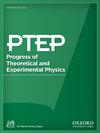Towards verifications of Krylov complexity
IF 8.3
4区 物理与天体物理
Q1 Physics and Astronomy
引用次数: 0
Abstract
Krylov complexity is considered to provide a measure of the growth of operators evolving under Hamiltonian dynamics. The main strategy is the analysis of the structure of Krylov subspace $\mathcal {K}_M(\mathcal {H},\eta )$ spanned by the multiple applications of the Liouville operator $\mathcal {L}$ defined by the commutator in terms of a Hamiltonian $\mathcal {H}$, $\mathcal {L}:=[\mathcal {H},\cdot ]$ acting on an operator η, $\mathcal {K}_M(\mathcal {H},\eta )=\text{span}\lbrace \eta ,\mathcal {L}\eta ,\ldots ,\mathcal {L}^{M-1}\eta \rbrace$. For a given inner product ( ·, ·) of the operators, the orthonormal basis $\lbrace \mathcal {O}_n\rbrace$ is constructed from $\mathcal {O}_0=\eta /\sqrt{(\eta ,\eta )}$ by Lanczos algorithm. The moments $\mu _m=(\mathcal {O}_0,\mathcal {L}^m\mathcal {O}_0)$ are closely related to the important data {bn} called Lanczos coefficients. I present the exact and explicit expressions of the moments {μm} for 16 quantum mechanical systems which are exactly solvable both in the Schrödinger and Heisenberg pictures. The operator η is the variable of the eigenpolynomials. Among them six systems show a clear sign of ‘non-complexity’ as vanishing higher Lanczos coefficients bm = 0, m ≥ 3.努力验证克雷洛夫复杂性
克雷洛夫复杂性被认为是在汉密尔顿动力学条件下演化算子增长的一个度量。主要策略是分析克雷洛夫子空间$\mathcal {K}_M(\mathcal {H},\eta )$的结构,该子空间由柳维尔算子$\mathcal {L}$ 的多重应用所跨越,柳维尔算子$\mathcal {L}$ 由换向器定义,换向器以哈密尔顿算子$\mathcal {H}$, $\mathcal {L}:=[\mathcal {H},\cdot ]$ 作用于算子η,$\mathcal {K}_M(\mathcal {H},\eta )=\text{span}\lbrace \eta ,\mathcal {L}\eta ,\ldots ,\mathcal {L}^{M-1}\eta \rbrace$。对于给定的算子内积(-, -),正交基础 $\lbrace {O}_n\rbrace$ 是通过 Lanczos 算法从 $\mathcal {O}_0=\eta /\sqrt{(\eta ,\eta )}$ 构造出来的。矩 $\mu _m=(\mathcal {O}_0,\mathcal {L}^m\mathcal {O}_0)$ 与称为 Lanczos 系数的重要数据 {bn} 密切相关。我提出了 16 个量子力学系统的矩 {μm} 的精确和明确表达式,这些系统在薛定谔图景和海森堡图景中都是可以精确求解的。算子η是特征多项式的变量。其中六个系统显示出明显的 "非复杂性 "迹象,即高兰克佐斯系数 bm = 0,m ≥ 3。
本文章由计算机程序翻译,如有差异,请以英文原文为准。
求助全文
约1分钟内获得全文
求助全文
来源期刊

Progress of Theoretical and Experimental Physics
PHYSICS, MULTIDISCIPLINARY-PHYSICS, PARTICLES & FIELDS
CiteScore
12.00
自引率
5.70%
发文量
148
审稿时长
17 weeks
期刊介绍:
Progress of Theoretical and Experimental Physics (PTEP) is an international journal that publishes articles on theoretical and experimental physics. PTEP is a fully open access, online-only journal published by the Physical Society of Japan.
PTEP is the successor to Progress of Theoretical Physics (PTP), which terminated in December 2012 and merged into PTEP in January 2013.
PTP was founded in 1946 by Hideki Yukawa, the first Japanese Nobel Laureate. PTEP, the successor journal to PTP, has a broader scope than that of PTP covering both theoretical and experimental physics.
PTEP mainly covers areas including particles and fields, nuclear physics, astrophysics and cosmology, beam physics and instrumentation, and general and mathematical physics.
 求助内容:
求助内容: 应助结果提醒方式:
应助结果提醒方式:


